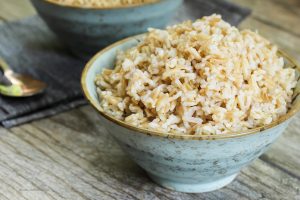Consumer Reports has released new data and guidelines for consumers about arsenic in rice. That organization’s 2012 report found measurable levels of the heavy metal in almost all of the products they tested. People who are allergic to wheat, celiac patients, and those sensitive to gluten eat more rice and rice products.
 Arsenic is in two forms: inorganic and organic. Inorganic is more toxic and is classified as a carcinogen. It is naturally occurring, but humans put more arsenic into the environment through pesticides and poultry fertilizer. Chickens are fed organic arsenic to promote weight gain and growth on less food. The FDA stopped approval of most food animal drugs containing arsenic last year, but not all. The heavy metal stays in the soil for decades. And when animals eat organic arsenic, their bodies convert it to inorganic arsenic. Rice takes up arsenic in the soil as it grows.
Arsenic is in two forms: inorganic and organic. Inorganic is more toxic and is classified as a carcinogen. It is naturally occurring, but humans put more arsenic into the environment through pesticides and poultry fertilizer. Chickens are fed organic arsenic to promote weight gain and growth on less food. The FDA stopped approval of most food animal drugs containing arsenic last year, but not all. The heavy metal stays in the soil for decades. And when animals eat organic arsenic, their bodies convert it to inorganic arsenic. Rice takes up arsenic in the soil as it grows.
This new report looked at data released by the FDA in 2013 on inorganic arsenic content of 656 processed rice-containing products. They found that rice cereal and rice pasta can have much more inorganic arsenic than the 2012 data showed. One serving of either product could put kids over the maximum amount of rice they should have in a week. There is no federal limit for arsenic in rice and rice products, although food safety advocates have been asking the government to set one for years.
In addition, rice cakes supply close to a child’s weekly limit of arsenic in one serving. And rice milk should not be given to children younger than five. When Consumer Reports shared this information with the FDA, the government’s response was that everyone should eat a variety of grains, and that parents “should consider options other than rice cereal for a child’s first solid food.” And the USA Rice Federation says that the benefits of rice in the diet outweigh the “potential risks” of arsenic exposure. Consumer Reports believes those levels are a risk.
Consumer Reports’ testing found that the levels of inorganic in a product vary depending on the type of rice and where it as grown. White basmati rice from California, India, and Pakistan and sushi rice from the U.S. has half of the inorganic arsenic content of most other types. Rice from Arkansas, Louisiana, Texas, or the U.S. in general had the highest levels of inorganic arsenic. Brown rice has 80% more inorganic arsenic than white rice of the same type, since the metal accumulates in the grain’s outer layers, which are removed to make white rice. And unfortunately, rice that is grown organically takes up the same amount of arsenic as the conventionally grown grain.
Regular exposure to small amounts of arsenic increases the risk of bladder cancer, lung cancer, and skin cancer, along with heart disease and type 2 diabetes. Rinsing rice thoroughly before cooking can remove about 30% of the arsenic. And other grains may be a better choice for your family. Quinoa, buckwheat, and millet have less arsenic but still provide whole grain nutrition.
Consumer Reports has developed a chart listing products, serving size, and points assigned to the product depending on how much arsenic it contains and whether a child or an adult is eating it. They propose you eat only 7 points per week. Rice cakes provide 6-1/4 points for a child, while rice cake or muffin mix provides 3-3/4 points and rice drinks provide 4. Hot rice cereal, at 8-1/4 points for a child, is the highest on the list.




